In recent years, the pitaya—commonly known as dragon fruit—has been gaining significant traction among Kenyan farmers. This exotic fruit, which was voted the superfruit of 2013, has only begun to make its mark in Kenya’s agricultural landscape over the past five years.
Let us look at how to farm dragon fruit in Kenya and the profits you are likely to enjoy.
Also Read: How to plant and earn from Garlic Farming in Kenya
What is a Dragon Fruit?
Dragon fruit, scientifically known as Hylocereus, is an exotic fruit belonging to the cactus family. It boasts a striking appearance that lives up to its mythical name. The fruit is typically oval-shaped, adorned with bright pink or yellow skin covered in green, scale-like protrusions reminiscent of a dragon’s hide.
The interior of the fruit presents an equally captivating sight. Depending on the variety, the flesh can be white or a vibrant red, generously speckled with tiny black seeds.
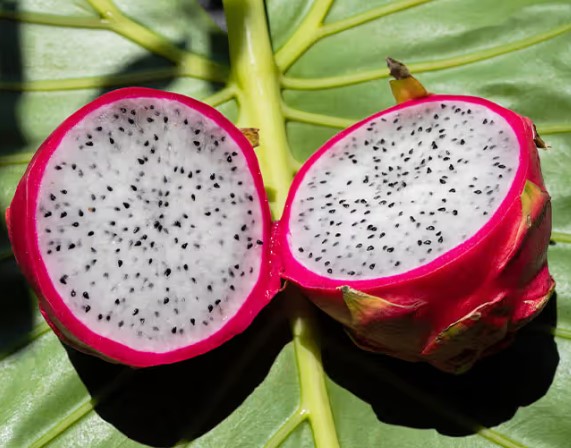
Dragon fruits are classified as epiphytic cacti, meaning they naturally grow on other plants, using their roots primarily for anchoring rather than nutrient absorption. This characteristic makes them well-suited to warm, arid environments where they can flourish with minimal water and maintenance.
Dragon Fruit Farming in Kenya – Varieties Suitable for Kenyan Climate
Kenya’s diverse climate zones offer favorable conditions for cultivating several dragon fruit varieties. The most commonly grown varieties include:
1. Hylocereus undatus (White-Fleshed Dragon Fruit)
This variety is characterized by its vivid pink or yellow exterior and white interior flesh dotted with black seeds. It offers a mild, subtly sweet flavor and is highly sought after in both local and international markets.
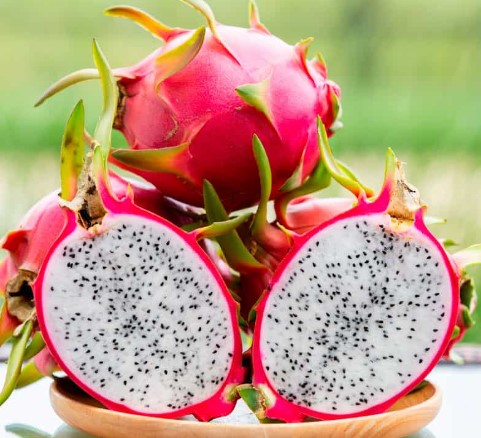
2. Hylocereus costaricensis (Red-Fleshed Dragon Fruit)
Distinguished by its deep magenta or red skin and flesh, this variety presents a visually striking appearance. The flavor is notably sweeter than its white-fleshed counterpart, making it a favorite among consumers seeking a more intense taste experience.
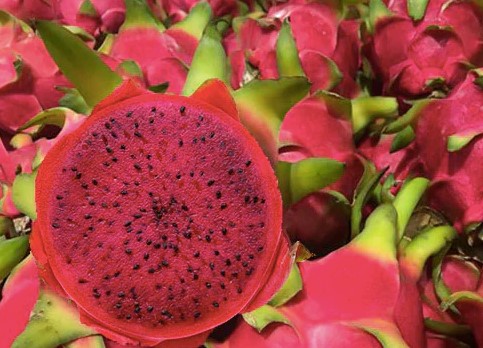
3. Selenicereus megalanthus (Yellow-Fleshed Dragon Fruit)
This variety stands out with its bright yellow skin and white flesh speckled with small black seeds. It offers a unique flavor profile with a subtle tanginess, appealing to those looking for a refreshing and distinctive taste.
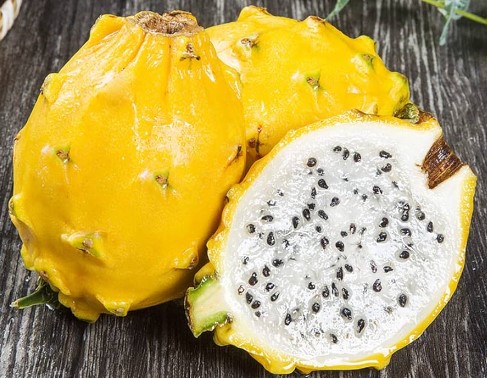
Regions in Kenya Best Suited for Dragon Fruit Farming
Dragon fruit cultivation can be successful in various parts of Kenya, each offering distinct advantages:
1. Coastal Regions: Areas such as Mombasa, Kilifi, Malindi, and Lamu provide ideal conditions for dragon fruit farming. These regions benefit from warm temperatures, high humidity, and moderate rainfall, creating an optimal environment for dragon fruit growth.
2. Lowlands: Regions like Tana River, Garissa, and parts of Eastern Kenya also present favorable conditions for dragon fruit cultivation. These areas offer warm temperatures and abundant sunlight, crucial factors for the cactus-like plant.
3. Parts of the Rift Valley: The Rift Valley, including areas like Naivasha, Nakuru, and Kericho, offers a range of microclimates suitable for dragon fruit farming. Regions such as Naivasha and Nakuru, characterized by warm days and cooler nights, provide an excellent environment for dragon fruit plants.
4. Central Highlands: Specific areas within the Central Highlands, including Thika, Murang’a, and Kiambu, can support dragon fruit farming with proper management. While generally cooler, these regions have pockets with warm temperatures and adequate sunlight exposure.
5. Western Kenya: Areas such as Kisumu, Kakamega, and Bungoma in Western Kenya also offer suitable conditions for dragon fruit farming. These regions benefit from warm temperatures and moderate to high rainfall, which can support robust plant growth.
How to Plant Dragon Fruit in Kenya
Dragon fruit can be propagated through seeds, cuttings, or tissue culture. However, cuttings are the most common and recommended method for commercial farming.
Here’s a step-by-step guide on how to propagate dragon fruit plants from cuttings:
Materials You’ll Need to plant dragon fruit plant
You’ll need the following:
1. Mature Dragon Fruit Plant: Choose a healthy and mature dragon fruit plant from which to take cuttings.
2. Sharp Pruning Shears or Knife: You’ll need a clean and sharp tool for cutting the plant.
3. Rooting Hormone (Optional): Rooting hormone can help stimulate root growth in the cuttings, but it’s not always necessary.
4. Pots or Containers: You’ll need pots or containers to plant the cuttings.
5. Well-Draining Potting Mix or Soil: Prepare a potting mix or soil that is well-draining and suitable for cacti and succulents. You can mix potting soil with perlite or sand to improve drainage.
6. Support Structures: Have support structures ready for the cuttings to climb once they establish roots.
How to Propagate Dragon Fruit Plant – Step by step
With the materials ready, do the following:
1. Select the Cuttings
Choose healthy stem segments or cuttings from the mature dragon fruit plant. These cuttings should be at least 12 to 18 inches (30-45 cm) long and have no signs of disease or damage.
2. Prepare the Cuttings
Cut the selected stems into segments, ensuring that each segment has at least one “node.” A node is a small bump or nub on the stem where roots and new growth will develop.
3. Let the Cuttings Dry (Optional)
Some gardeners recommend allowing the cuttings to air dry for a few days before planting. This can help prevent rotting. If you choose to do this, place the cuttings in a shaded area with good airflow.
4. Plant the Cuttings
Fill your pots or containers with the well-draining potting mix. Insert the cuttings into the soil, burying one-third of each cutting. Make sure the nodes are below the soil surface. You can plant multiple cuttings in one pot.
5. Watering
Water the cuttings lightly after planting to settle the soil around them. Be careful not to overwater, as dragon fruit cuttings are sensitive to excess moisture. Water sparingly until you see signs of growth.
6. Provide Support
Place the pots or containers in a location where the cuttings will receive indirect sunlight. As the cuttings grow, provide them with support structures for climbing, such as trellises or stakes.
7. Root Development
Over time, the cuttings will develop roots. This process can take several weeks to a few months, depending on conditions. You can gently tug on the cuttings to check if they are anchored by roots.
8. Transplanting
Once the cuttings have established roots and are growing well, you can transplant them into your desired growing location, whether it’s in the ground or larger containers. Ensure they have adequate support structures to climb.
9. Care and Maintenance
Continue caring for your dragon fruit plants by providing proper sunlight, well-draining soil, and minimal but consistent watering. Fertilize if needed with a balanced, water-soluble fertilizer.
How Many Dragon Fruit Plants Grow per Acre in Kenya? Spacing and Planting Density
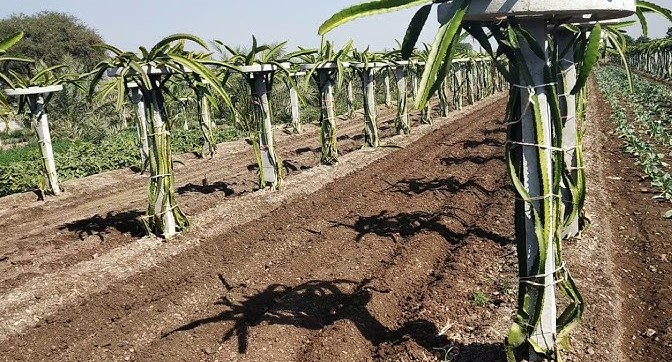
Proper spacing and planting density are crucial factors in dragon fruit cultivation, affecting not only the yield but also the overall health and management of the orchard.
In Kenya, where dragon fruit farming is relatively new, understanding these aspects is essential for successful cultivation.
Recommended Spacing and Plant Density
For commercial dragon fruit cultivation in Kenya, a common recommended spacing is 2 meters by 2 meters (6.6 feet by 6.6 feet). This spacing allows for:
– Efficient use of land
– Adequate sunlight penetration
– Sufficient air circulation
– Easy access for maintenance and harvesting
Using this spacing, the theoretical plant density per acre is calculated as follows:
1 acre = 43,560 square feet
Planting space per plant = 2m x 2m = 4 square meters ≈ 43 square feet
Number of plants per acre = 43,560 ÷ 43 ≈ 1,013 plants
However, practical considerations often reduce this number. Accounting for pathways, irrigation systems, and other infrastructure, a more realistic estimate is around 800-900 plants per acre.
Multiple Plants per Support Structure
To maximize yield and efficiency, many growers plant multiple dragon fruit cuttings around a single support structure:
– Typically, 2-4 plants are planted per support pole.
– This method increases the plant density to 1,600-3,200 plants per acre.
– In some intensive systems, up to 6,400 plants per acre have been reported, though this high density requires careful management.
Adapting Spacing to Local Conditions
Kenyan farmers should consider adapting these general guidelines to their specific conditions:
– In drier regions, slightly wider spacing may be beneficial to reduce competition for water.
– In areas with high humidity, wider spacing helps prevent fungal diseases.
– Small-scale or backyard growers can be more flexible with spacing, focusing on integrating dragon fruit with other crops or landscape elements.
Care and Maintenance of Dragon Fruit Plants
Proper care and maintenance are essential for ensuring healthy growth and optimal yield of dragon fruit plants in Kenya. Here are detailed practices for successful cultivation:
1. Watering
Dragon fruit plants are drought-tolerant but require consistent moisture for optimal growth and fruit production. Watering frequency depends on climate, soil type, and plant age:
– Young plants: Water 2-3 times per week
– Established plants: Deep watering once every 7-10 days
Use drip irrigation or soaker hoses to deliver water directly to the root zone. Avoid overhead watering to prevent fungal diseases. Also, reduce watering during the cooler months to prevent waterlogging.
2. Soil and Fertilization
Dragon fruit prefers well-draining, slightly acidic soil (pH 5.5-6.5). While dragon fruit can grow in relatively poor soils, proper fertilization enhances growth and fruit quality:
– Organic fertilizers: Compost, well-rotted manure, or organic pellets (apply quarterly)
– Inorganic fertilizers: Balanced NPK fertilizer (10-10-10 or 14-14-14) applied monthly during the growing season
Avoid excessive nitrogen, which can promote vegetative growth at the expense of fruit production. Apply micronutrients (especially iron and magnesium) if deficiency symptoms appear.
3. Pruning and Training
Regular pruning is crucial for maintaining plant health and productivity.
– Remove dead, diseased, or crossing branches
– Thin out dense growth to improve air circulation
– Prune after harvest to encourage new growth
– Train vines up support structures, tying them loosely with soft ties.
– Pinch off the growing tips of young plants to encourage branching.
4. Pest and Disease Management
While dragon fruit is relatively pest-resistant, monitor for:
– Mealybugs: Control with insecticidal soap or neem oil
– Fruit flies: Use pheromone traps and fruit bagging
– Ants: Control with baits or physical barriers
Common diseases include:
– Stem rot: Caused by overwatering or poor drainage. Improve soil conditions and reduce watering.
– Sunburn: Provide shade during extreme heat or use kaolin clay sprays.
Harvesting and Handling Dragon Fruit
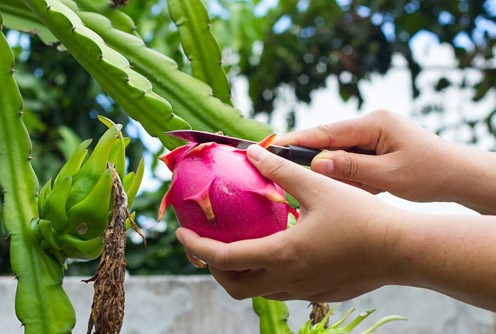
Proper harvesting and post-harvest handling are crucial for maintaining fruit quality and maximizing market value:
1. Determining Harvest Readiness
Dragon fruit typically matures 30-50 days after flowering. Signs of ripeness include:
– Vibrant skin color (bright pink or yellow, depending on variety)
– Slight softening of the fruit
– Scales on the fruit surface start to wither and turn reddish
– A sweet aroma near the base of the fruit
2. Harvesting Technique
– Use clean, sharp pruning shears or a knife to cut the fruit from the plant.
– Leave a short stem attached to the fruit to prevent moisture loss.
– Harvest during the cooler parts of the day (early morning or late evening) to maintain fruit quality.
3. Post-Harvest Handling
– Handle fruits gently to avoid bruising or damaging the skin.
– Sort fruits based on size and quality.
– Clean fruits gently with a soft brush to remove any dirt or debris.
4. Storage
Store dragon fruits at 10-12°C (50-54°F) with 90-95% relative humidity. Properly stored fruits can maintain quality for up to 2-3 weeks. For short-term storage, keep fruits at room temperature away from direct sunlight.
Dragon Fruit Yield Per Acre in Kenya
In Kenya, dragon fruit yield can vary based on several factors, including plant age, variety, management practices, and environmental conditions.
According to experienced Kenyan farmers, dragon fruit yield typically follows this pattern:
First Two Years:
– Average yield: 6,500 kg per acre
– Assuming a plant population of 2,400 plants per acre
Mature Orchard (3+ years)
– Yield increases to 10,000 – 12,000 kg per acre
– This increase is due to plant maturity and improved management practices
Individual Fruit Weight
– Each dragon fruit typically weighs between 300 – 1,000 grams
– This wide range is due to variations in variety, growing conditions, and management practices
Cost and Profitability of Dragon Fruit Farming in Kenya
Here’s a breakdown of the initial investment, ongoing expenses, and potential returns for a one-acre dragon fruit orchard in Kenya:
Initial Investment:
1. Land Preparation:
– Digging 1,200 holes @ 40 KSh/hole = 48,000 KSh
– This includes labor for digging and initial soil amendment
2. Irrigation System Setup:
– Estimated cost: 80,000 KSh
– Includes drip irrigation lines, filters, and a small pump system
3. Trellising System
– 1,200 poles @ 300 KSh/pole = 360,000 KSh
– Includes poles, wire, and installation labor
4. Planting Material
– 6,400 seedlings or cuttings @ 500 KSh each = 3,200,000 KSh
– High-quality, disease-free planting material is crucial for long-term success
Total Initial Investment: 3,688,000 – 3,688,000 KSh
Annual Operational Expenses
1. Labor: 5,000 KSh
– Includes regular maintenance, harvesting, and post-harvest handling
2. Fertilizers and Soil Amendments: 4,500 KSh
– Organic and inorganic fertilizers, micronutrients, and pH adjusters
3. Pest and Disease Management: 4,500 KSh
– Integrated pest management supplies and occasional pesticide applications
4. Pruning and Training: 5,000 KSh
– Specialized labor for canopy management
5. Miscellaneous Expenses: 20,000 KSh
– Includes small equipment repairs, fuel for irrigation pumps, and marketing costs
Total Annual Operational Expenses: 39,000 KSh
Total Cost (First Year): Initial Investment + Annual Expenses = 3,727,000 – 3,727,000 KSh
Yield and Revenue Projections
1. Conservative Estimate:
– Yield: 15 kg per plant
– Price: 500 KSh per kg
– Revenue: (15 kg × 6,400 plants × 500 KSh/kg) = 48,000,000 KSh
2. Optimistic Estimate:
– Yield: 25 kg per plant
– Price: 1,200 KSh per kg
– Revenue: (25 kg × 6,400 plants × 1,200 KSh/kg) = 192,000,000 KSh
Profit Calculations:
1. Conservative Scenario:
– Revenue: 48,000,000 KSh
– Total Cost: 3,727,000 KSh
– Profit: 44,273,000 KSh per acre
2. Optimistic Scenario:
– Revenue: 192,000,000 KSh
– Total Cost: 3,727,000 KSh
– Profit: 188,273,000 KSh per acre
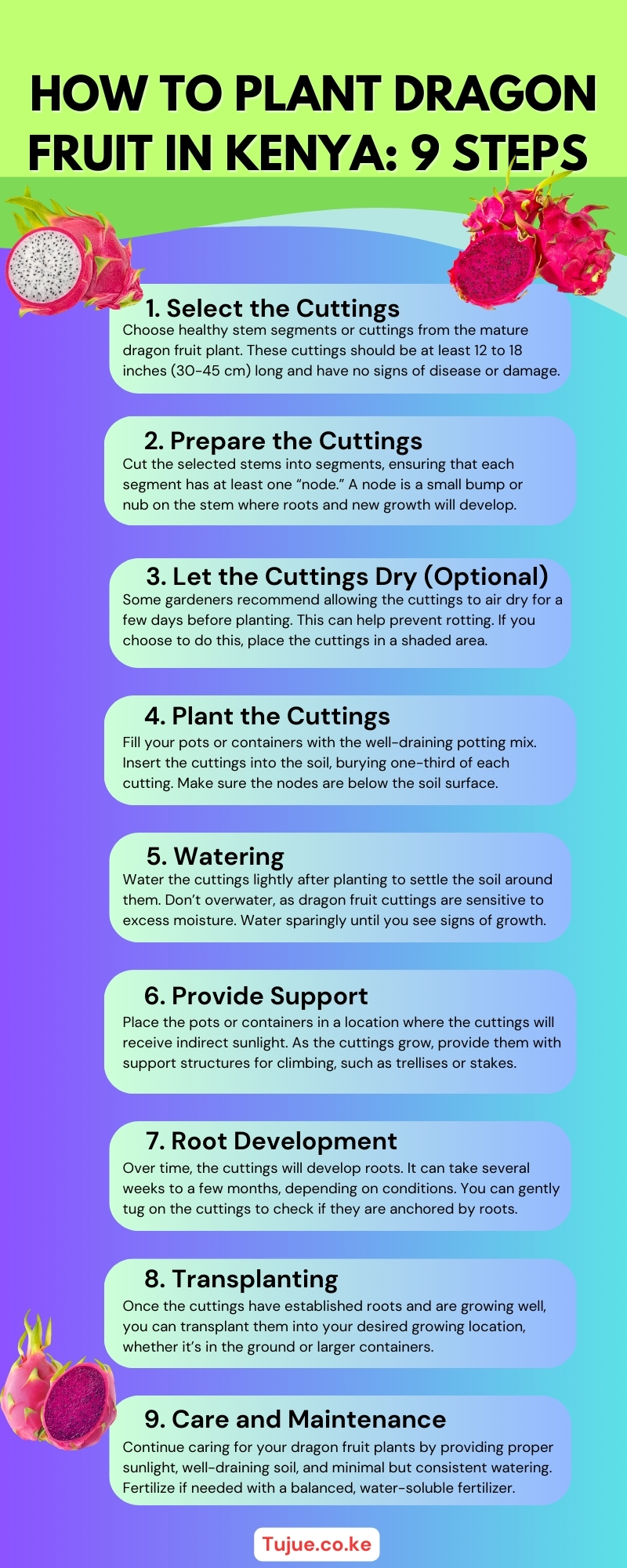
How to Plant Dragon Fruit in Kenya Infographic
Happy Farming!
Dragon fruit farming in Kenya presents a promising opportunity for agricultural diversification and economic growth.
As we’ve explored throughout this comprehensive guide, the cultivation of this exotic fruit offers significant potential for both small-scale and commercial farmers across various regions of the country.
As with any agricultural venture, success in dragon fruit farming requires dedication, careful planning, and ongoing education. Farmers are encouraged to stay informed about the latest cultivation techniques, market trends, and pest management strategies to maximize their chances of success.

